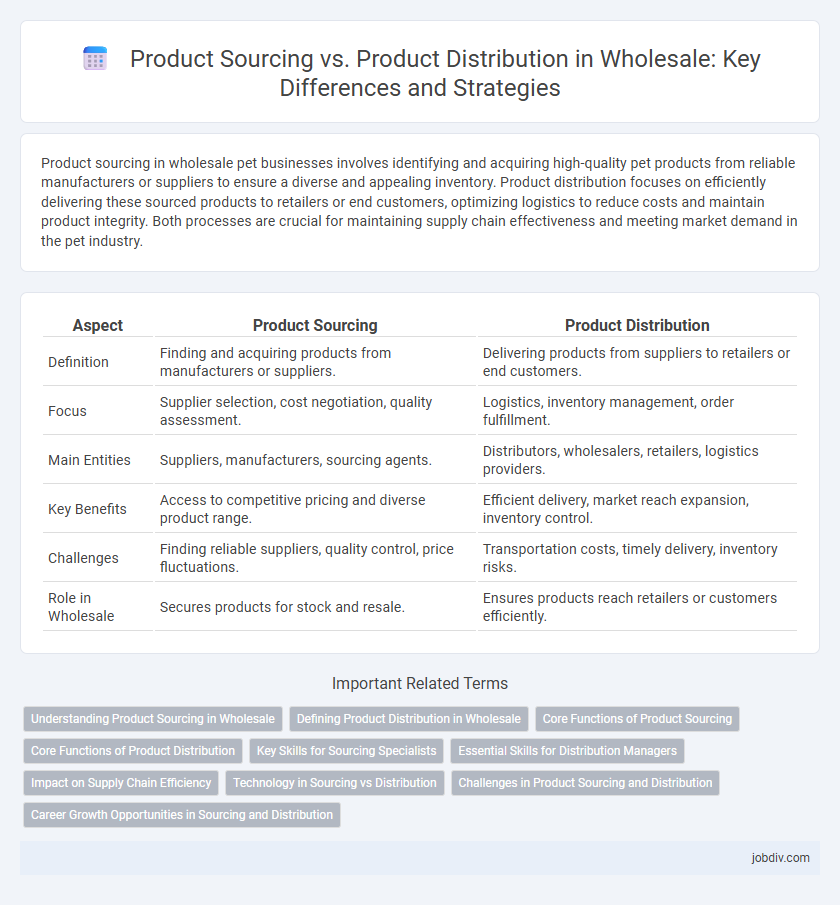Product sourcing in wholesale pet businesses involves identifying and acquiring high-quality pet products from reliable manufacturers or suppliers to ensure a diverse and appealing inventory. Product distribution focuses on efficiently delivering these sourced products to retailers or end customers, optimizing logistics to reduce costs and maintain product integrity. Both processes are crucial for maintaining supply chain effectiveness and meeting market demand in the pet industry.
Table of Comparison
| Aspect | Product Sourcing | Product Distribution |
|---|---|---|
| Definition | Finding and acquiring products from manufacturers or suppliers. | Delivering products from suppliers to retailers or end customers. |
| Focus | Supplier selection, cost negotiation, quality assessment. | Logistics, inventory management, order fulfillment. |
| Main Entities | Suppliers, manufacturers, sourcing agents. | Distributors, wholesalers, retailers, logistics providers. |
| Key Benefits | Access to competitive pricing and diverse product range. | Efficient delivery, market reach expansion, inventory control. |
| Challenges | Finding reliable suppliers, quality control, price fluctuations. | Transportation costs, timely delivery, inventory risks. |
| Role in Wholesale | Secures products for stock and resale. | Ensures products reach retailers or customers efficiently. |
Understanding Product Sourcing in Wholesale
Product sourcing in wholesale involves identifying, evaluating, and procuring products directly from manufacturers or authorized suppliers to ensure quality and cost efficiency. Effective sourcing strategies include conducting market research, negotiating favorable terms, and maintaining strong supplier relationships to optimize inventory and reduce lead times. Understanding product sourcing is essential for wholesalers to secure competitive pricing, ensure product availability, and meet customer demand reliably.
Defining Product Distribution in Wholesale
Product distribution in wholesale involves the process of delivering products from manufacturers or suppliers to retailers or end consumers through an established network. It encompasses logistics, inventory management, transportation, and order fulfillment to ensure timely and efficient movement of goods. Effective distribution strategies optimize supply chain operations, reduce costs, and increase market reach in the wholesale industry.
Core Functions of Product Sourcing
Product sourcing in wholesale primarily involves identifying and acquiring products from reliable manufacturers or suppliers to ensure quality and cost-effectiveness. It requires market research, supplier negotiation, and quality control to maintain a consistent supply chain. Effective product sourcing directly impacts inventory management and pricing strategies essential for competitive distribution.
Core Functions of Product Distribution
Product distribution in wholesale primarily involves the efficient delivery of goods from manufacturers to retailers or end customers, ensuring timely availability and inventory management. Core functions include warehousing, order fulfillment, transportation logistics, and demand forecasting to minimize stockouts and reduce lead times. Effective product distribution enhances supply chain visibility, optimizes cost efficiency, and supports market responsiveness.
Key Skills for Sourcing Specialists
Sourcing specialists in wholesale excel in supplier negotiation, market analysis, and inventory forecasting to secure high-quality products at competitive prices. Their ability to assess supplier reliability and compliance ensures consistent product availability, reducing supply chain risks. Expertise in cost management and contract negotiation distinguishes sourcing professionals from distribution-focused roles that prioritize logistics and delivery optimization.
Essential Skills for Distribution Managers
Distribution managers in wholesale must excel at inventory management, demand forecasting, and logistics coordination to ensure products move efficiently from suppliers to customers. Strong negotiation skills with carriers and suppliers enable cost-effective transportation and timely delivery. Mastery of data analytics tools is crucial for optimizing supply chain operations and responding swiftly to market fluctuations.
Impact on Supply Chain Efficiency
Product sourcing directly influences supply chain efficiency by determining the quality, cost, and reliability of incoming materials, which affects production timelines and inventory management. Product distribution streamlines the movement of finished goods to various markets, minimizing delays and reducing transportation costs. Optimizing both sourcing and distribution processes enhances overall supply chain responsiveness and cost-effectiveness in wholesale operations.
Technology in Sourcing vs Distribution
Technology in product sourcing leverages AI-driven analytics and blockchain for enhanced supplier transparency, ensuring efficient identification and verification of high-quality products. In contrast, distribution technology emphasizes advanced logistics software, IoT-enabled tracking, and automated warehouse management to optimize delivery speed and inventory accuracy. Seamless integration of sourcing platforms with distribution systems enhances end-to-end supply chain visibility, reducing costs and improving overall wholesale efficiency.
Challenges in Product Sourcing and Distribution
Product sourcing in wholesale faces challenges such as supplier reliability, quality control, and fluctuating market prices, which can disrupt inventory consistency. Distribution hurdles include transportation logistics, timely delivery, and managing storage costs, impacting overall supply chain efficiency. Coordinating sourcing and distribution effectively is crucial to minimize delays and maintain customer satisfaction in competitive wholesale markets.
Career Growth Opportunities in Sourcing and Distribution
Product sourcing careers offer strategic roles in supplier negotiation, market analysis, and inventory management, fostering skills in global trade and cost optimization. Product distribution careers emphasize logistics coordination, supply chain management, and delivery optimization, enhancing expertise in transportation networks and customer service. Both paths present significant growth opportunities, with sourcing leading to procurement leadership and distribution opening pathways to operations management.
Product Sourcing vs Product Distribution Infographic

 jobdiv.com
jobdiv.com